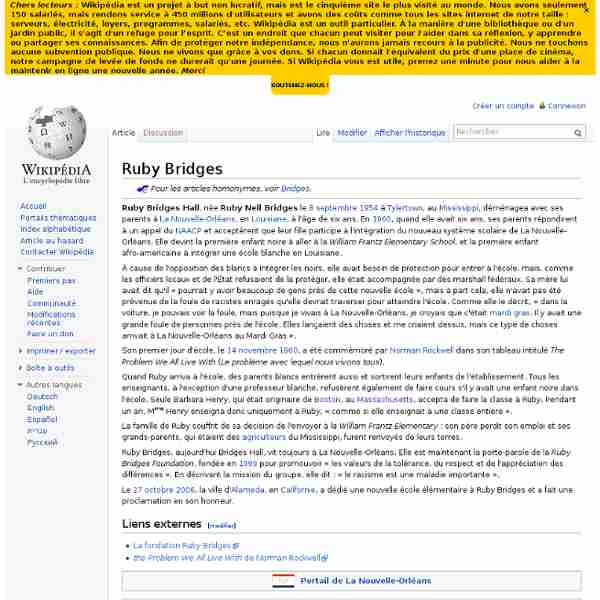Norman Rockwell. "The problem we all live with".(fiche élève 2012) - Bellevue-CDI
Tableau de Norman Rockwell qui se trouve au Norman Rockwell museum .Il s'agit d'une illustration faite pour le magazine Américain Look , publié en 1964.Il mesure 91.4 cm sur 147.3 cm. Le contexte historique : Entre les années 1880 et 1960 , les lois de ségrégation nommées JIM CROW LAWS (lois Jim Crow) ont été appliquées dans tout le Sud. Ces lois sont les héritières des Codes Noirs qui avaient été appliqués auparavant.Les Lois Jim Crows sont discriminatoires et partent de préjugés raciaux : les personnes de couleur ne sont pas les égaux des blancs , et chaque "race" doit être séparée, dans la vie quotidienne depuis la naissance jusqu'à la mort. Peinture à l'huile. Les couleurs : le blanc = innocence/pureté .Accentue le contraste avec la peau de l'enfant. Le rouge sur le mur = violence, agressivité , sang pour marquer l'hostilité de la population blanche manifestant contre l'entrée de l'enfant à l'école Primaire WILLIAM FRANTZ . Attitude des personnages La tomate = hostilité des blancs
The Problem We All Live With
Un article de Wikipédia, l'encyclopédie libre. Description[modifier | modifier le code] Notes et références[modifier | modifier le code] ↑ (fr) « The Problem we All Live With » [archive], sur Académie de Toulouse (consulté le 26 mars 2014).↑ a et b (en) « The Problem We All Live With, Norman Rockwell, 1963. Voir aussi[modifier | modifier le code] Articles connexes[modifier | modifier le code] Liens externes[modifier | modifier le code] (en) Commentaires de Ruby Bridges et Barack Obama, suite à leur examen conjoint du tableau The Problem We All Live With dans l'aile Ouest de la Maison-Blanche, sur youtube.com (consulté le 26 mars 2014).
#31: The Problem We All Live With by Norman Rockwell
#31: The Problem We All Live With by Norman Rockwell The Problem We All Live With by Norman Rockwell, 1964 This analysis copyright Scott M. McDaniel, 2010 The Image Larger Version Driving up I could see the crowd, but living in New Orleans, I actually thought it was Mardi Gras. On November 14, 1960 federal marshals escorted Ruby Hall to her first day of kindergarten. Norman Rockwell painted this picture for Look magazine. Black and White A good illustration needs a clear silhouette. Ruby’s white dress works with her dark skin to create the high contrast and to create the silhouette that all by itself communicates the idea of a walking African American schoolgirl. Direction I’m not going to go into color palette and choices very much, but I do want to point out how Rockwell uses saturation. Everything is greyscale except for the areas inside the ovals, which I left as they appear in the painting. My eye starts at A. Composition Message and Symbolism The Elements
The Problem we all live with – NORMAN ROCKWELL 1964 · Pauline histoire des arts
Et voilà une seconde oeuvre à étudier : Norman ROCKWELL The problem we all live with – 1964 ! Celle-ci parle de Rosa Park , qui fut la première petite fille « noire » à aller dans une école de « blancs » aux Etats Unis. Le mouvement Artistique étudié est l’Hyperréalisme. C’est un courant artistique né aux ETATS UNIS, caractérisé par un rendu minutieux de la réalité inspiré d’images photographiques. Dans les années 1960, l’hyperréalisme adhère au réel par imitation de la technique précise des gros plans photographiques, tout en manipulant certains détails, amenant le spectateur à une réflexion sur la notion même de réalité. L’hyperréalisme consiste en la reproduction à l’identique d’une photographie en peinture, tellement réaliste que le spectateur vient à se demander si la nature de l’œuvre est une peinture ou une photographie. (Sources : leblogdechonchon.over-blog.com ; Wikipédia ; ARTS PLASTIQUES AU XXe SIECLE DELAGRAVE ) ( Source : peintremik.com ) Demarche Artistique : Description:
“Rockwell & Race”1963-1968 | The Pop History Dig
Norman Rockwell’s painting of six year-old Ruby Bridges being escorted into a New Orleans school in 1960 was printed inside the January 14, 1964 edition of Look magazine. Click for art print. In June 2011 at the White House, Norman Rockwell’s 1963 painting, The Problem We All Live With, depicting a famous school desegregation scene in New Orleans, began a period of prominent public display with the support of President Obama. Rockwell’s painting focuses on an historic 1960 school integration episode when six year-old Ruby Bridges had to be escorted by federal marshals past jeering mobs to insure her safe enrollment at the William Frantz Elementary School in New Orleans. Norman Rockwell at work, mid-career. Rockwell’s portrayal first appeared to wide public notice in January 1964 when it ran as a two-page centerfold illustration on the inside pages of Look magazine. Norman Rockwell, circa 1940s. Norman Rockwell Civil Rights Subjects Cover Art, 1950s Click to read at PBS.org. Rockwell at Look
Anglais - Histoire des arts au collège de Mormant
L'artiste illustre ici une scène du quotidien comme il a l'habitude de le faire... En effet, quoi de plus banal qu'une fillette se rendant à l'école ? En revanche, les quatre US Marshalls qui l'accompagnent, l'espace dans lequel elle évolue, montrent que la scène n'est pas si banale que ça. Contexte : l'année 1964 voit aux Etats-Unis la désegregation des écoles (Cf. the Civil Right Act) ; cette fillette va dans une école "blanche" pour la première fois. Le thème de la fillette allant à l'école prend des allures d'un cortège sous haute sécurité ! Sur le mur et à son pied, une tomate rouge a été lancée, visant probablement la fillette. Toujours sur ce mur, les tags racistes "nigger" ou "KKK" finissent d'illustrer l'animosité d'une parie de la population. Notons : Movin'In Encore une scène de la vie quotidienne comme Norman Rockwell aimait les illustrer. Une famille noire s'installe dans le quartier... et visiblement, dans ce quartier-ci, c'est une grande première !



